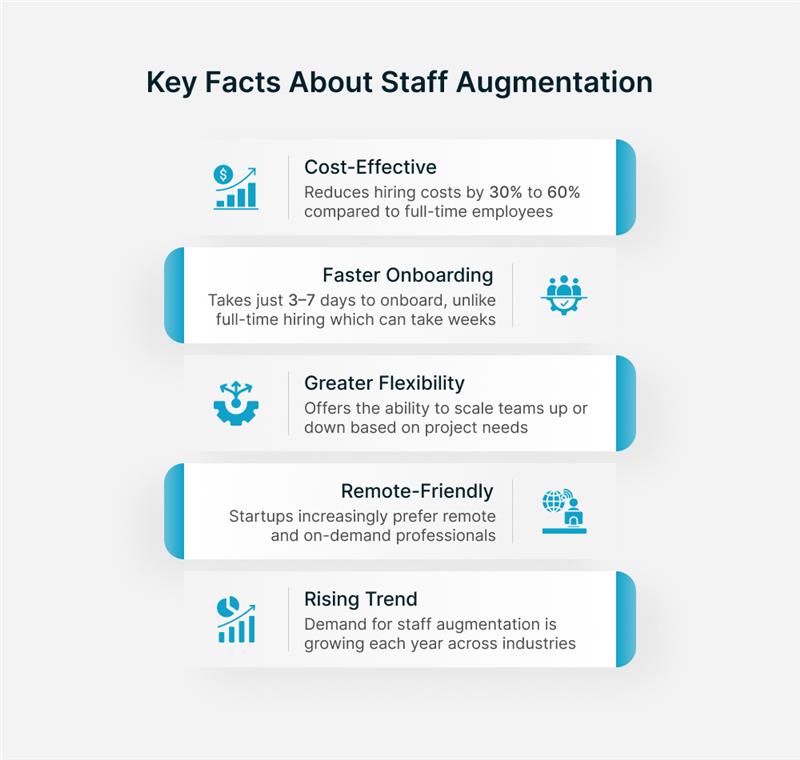5 Signs Your Startup Needs Staff Augmentation Instead of Full Time Hires
Picture a scenario where your startup is booming and growing rapidly, but you’re running into a roadblock. You need specialized skills, and you need them now. may seem like the wisest course of action to hire someone full-time, but is that actually the best option? The solution is not just about filling seats; it’s about strategically boosting your team with the right talent at the right time. That’s when you should consider staff augmentation. Read on to understand if your startup might be better off augmenting your team rather than hiring full-time.

1- You Need Niche Skills for a Short-Term Project
Let’s say that in order to remain competitive, your startup must incorporate a state-of-the-art blockchain payment system. You only require one particular integration; you are not creating a blockchain platform. It’s quite difficult to find a full-time blockchain developer with the exact knowledge you need. Due to the small talent pool for these highly specialized abilities, salaries are high and the process is expensive and time-consuming. You would have to spend months hiring, reviewing resumes, and holding technical interviews, while your project stalls.
An alternative to a costly and time-consuming employment process is staff augmentation, which gives you access to a global network of pre-screened blockchain developers. You can temporarily onboard someone with the exact experience you need and integrate your payment system in just a few days. After the project is complete, you can move on, without worrying about a permanent salary or benefits.
This agility gives you a double advantage. It helps you save money and allows you to take advantage of market opportunities before your competitors do. You’re not just filling a role; you’re strategically acquiring the precise expertise needed, exactly when you need it, and for exactly as long as you need it.
2- Your Project Scope Is Fluctuating
Startups are known for their unpredictable project scopes. You may devote one week to a viral marketing campaign that necessitates a surge in design and content creation. The next week, a promising new feature appears that needs resources for development right away. When your priorities change rapidly, full-time employees may end up becoming a liability.
Through staff augmentation, you can dynamically modify your team according to your project needs. This means how many members you have and their skillsets. For example, if you’re working on a project that needs a lot of creative talent, you can address that need by augmenting with skilled designers and content producers to execute the marketing campaign. If you need a little talent, skilled marketers, you can/or should have a team that is skilled, but more limited to what they handle. After the campaign is completed, you can scale back without worrying about layoffs. To keep a necessary level of agility and leanness, you need that ability to look more dynamic.
3- You’re Operating on a Tight Budget
Startups usually run on tight budgets, and hiring full-time involves a large upfront as well as ongoing expense burden. Benefits like health insurance, retirement contributions, and paid time off come at a substantial proportion beyond the base pay. Payroll taxes, which include both employer and employee contributions raise the cost. And to top it all, onboarding adds to the time and money required to train a new hire before they are fully productive.
Staff augmentation can be used to reduce these overheads. Instead of committing to a long-term, permanent arrangement, you are paying for specific skills, for a predetermined period of time, and only for the hours completed. This speeds up your time to market while also freeing up your finances. By using augmentation you can be more agile and cost-effective and focus on your main business objectives without being weighed down by the financial burdens of traditional hiring.
4- You Need to Accelerate Your Development Cycle
In the startup ecosystem, speed is paramount. Your competitors gain momentum every day that you lose due to drawn-out hiring procedures or ineffective onboarding. This is especially true in development, where delays can affect market share, diminish first-mover advantage, and postpone important product releases.
Staff augmentation solves this problem by providing on-demand access to qualified professionals. For instance, a serious bug is blocking you from launching a new app on time. Also, add experienced QA testers to your team who will immediately find and fix the issue. This could take weeks off of your timeline compared to hiring a full-time employee.
If there is a need to expedite your development timeline to meet a tight deadline, consider hiring experienced developers. They can quickly read the code, get hands-on, and contribute immediately without requiring extensive training or orientation.
5- You’re Testing a New Market or Feature
Imagine that your startup is working on a software as a service (SaaS) product for small businesses. You’ve read somewhere that personalized onboarding videos would begin to increase user engagement and retention tremendously – but you aren’t sure that personalized onboarding videos would be the best investment for your small startup. After all, hiring a full-time video producer and video editor can be a risk if you aren’t getting results.
Instead, you could onboard a freelance subject matter expert in video production on a temporary basis to create personalized onboarding videos for a small percentage of your user base as a pilot, and be able to see first hand the effect personalized video media has on engagement and retention without having the overhead payment of a full-time employee.
With successful pilot results and an increased engagement and retention, you can then begin to demonstrate to your users the value of adding more video content to the overall service. Alternatively, if the pilot didn’t produce the desired outcomes, you can pivot quickly and reposition your resources into other product development or marketing projects. This process allows you to take a leap, be flexible, and quickly validate new ideas while diminishing your risk.
Conclusion
Startups rely heavily on efficiency and agility. One strategy many organizations will consider is staff augmentation as a way to manage changes to existing project scopes, obtain specialized skill, stay on track for budget, reduce development cycles, and experiment with new ideas. In brief, staff augmentation is not a way to replace full-time employment, but a way to augment your team strategically to help you achieve your goals quicker and more efficiently.
Would you like to discuss how staff augmentation can benefit your startup? Contact us for a consultation and find out how we can help you build the perfect team for your unique needs.







